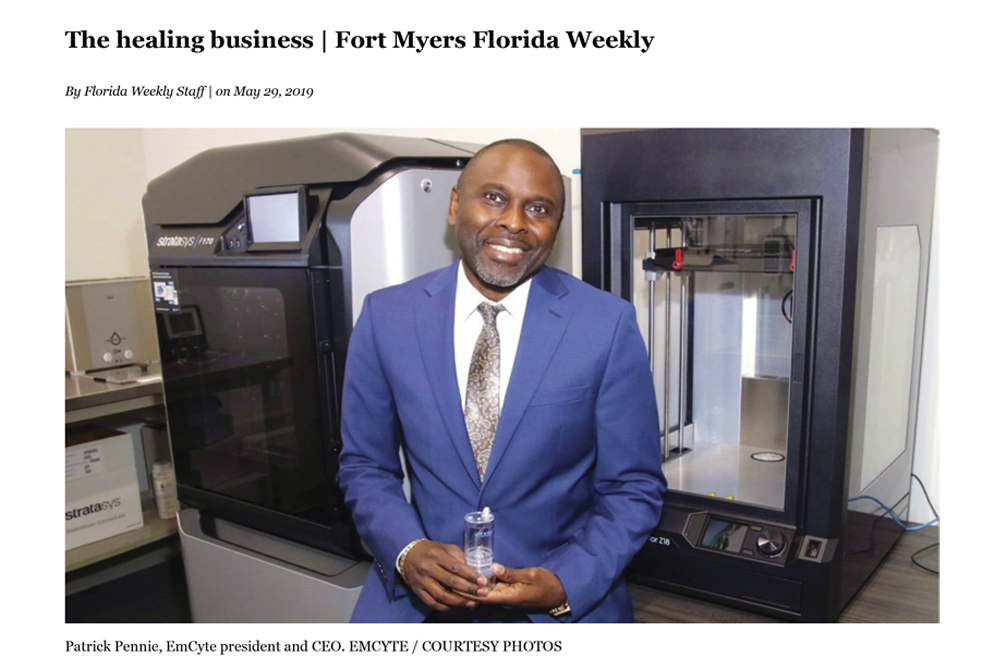
EVERY SO OFTEN AN ENTREPRENEUR arises inexplicably from the ranks of hard-working, dedicated, educated individuals who later may wish they’d thought of the same thing, but didn’t. That seems to be the case with Patrick Pennie, a 52-year-old native New Yorker trained and experienced as a critical-care registered nurse and open-heart perfusionist who could operate heart-lung machines during cardiac surgery or others requiring “cardiopulmonary bypass to manage the patient’s physiological status,” as one definition describes it.
That would seem to be ambitious enough for any single successful career, but no. Not for Mr. Pennie, who graduated from Barry University and worked in hospitals on both the east and west coasts for years. And he spent a decade fascinated by blood and the ways blood works — thinking about blood, reading and researching, he says — before finally learning not just the science and possibilities for treatments but the ins and outs of manufacturing, equipment and scrupulous government regulations.
EmCyte, based in Fort Myers.
Finally, in 2008 he created the EmCyte Corp., a Fort Myers-based company now selling its product to doctors and medical practices world-wide. Recently, he also opened an independent training and education facility for doctors and others, Gulf Coast Biologics, aimed at sharing the company’s research, medical studies and data, he says.
His idea, now a reality produced entirely in his FDA-approved, faultlessly clean 30,000-square-foot manufacturing site: platelet derived autologous regenerative medicine.
“Autologous” means it comes from the patient, in this case plasma drawn from an individual, reprocessed to be high in platelets and very low in red blood cells, and returned to the patient to heal injuries and arthritis in joints, bones, muscles and tendons.
“It sounds like bragging, but I consider myself one of the pioneers in the industry. I started doing PRP — platelet rich plasma — when the general public didn’t know what it was, or understand what it could offer,” he said.
“Now after almost 20 years of development, we offer one of the best PRP products on the market.”
It’s not bragging when such celebrated orthopedic surgeons as Dr. Alan Bauman at the Bauman Medical Group in Boca Raton, or Dr. Erick Grana of the Regenerative Orthopedic Institute in Tampa, or Dr. Thomas Sievert in Fort Myers, or Dr. Ronald Gardner of Gardner Orthopedics in Fort Myers all confirm the value of EmCyte’s platelet rich plasma — and other products made at EmCyte, where Mr. Pennie now holds two patents and a number of copyrights, including a patent on a centrifuge tube for separating and aspirating biological components, as a company fact-sheet describes it.
Thomas Edison would be proud. Dr. Gardner finds it extremely useful and dependable.
“They started this earlier and I got on board in 2009 — I’ve done about 2,000 sites now with EmCyte’s products,” he says. “It works in just about every arthritic shoulder I’ve used it on. Our greatest success rates come in shoulders, followed by elbows, wrists, hips, and then ankles. “The healthier a person is, the better it works, and the less degeneration, the better it works. So, if you have a bone-on-bone ankle arthritis, it’s probably not going to help.
“But if you have an early arthritis in the shoulder or knee, we can show improvements almost every time.”
A lot of people face those problems, Mr. Pennie notes, especially in an aging population. So the industry is growing. The global market for platelet rich plasma, which EmCyte products are reaching, may hit $400 million in the next four years with a 13.3 percent compound annual growth rate, according to a report in the online publication, Qurate Business Intelligence.
Dr. Gardner has used products from a wide range of manufacturers, he says — “probably every one out there.” One of the things that distinguishes EmCyte products is its cleanliness — it doesn’t break down or cause problems after administration.
“His products are the most reproducible, the least likely to fail or get contaminated during the handling process,” he explains. “That’s huge.”
As Mr. Pennie explains it, EmCyte creates a product “with really high platelet and growth factor concentrations and really low red blood cell content — those are the key elements in PRP.”
Some competing companies sometimes make it in the test tube, but they can’t get the high concentrations or dependability, even though patients will pay as much for treatment with those products as they do for EmCyte products, Mr. Pennie notes.
“So patients have to ask, where is the PRP coming from and how was it made?”
“These are key elements to (an effective) clinical PRP: platelet concentrations of six times or better, with a platelet yield of 80 percent or better, with red blood cell counts of less than 1 percent.
“There are a lot of products that do not provide those types of PRP performance. A lot of patients are out there getting treated by a low-quality PRP — that’s the sad part. Those patients pay between $1,500 or $3,000 to a physician to treat injury, or wounds, or for an aesthetic improvement they may not see.”
Dr. Gardner explains the science of such treatments this way: “The healing properties come from blood, specifically the platelets — you have red, white blood cells, and the platelets are the smallest cellular portion of your blood. You have 300 million in one cc of blood.
“Inside these platelets are packets of growth factors, a whole bunch of different kinds: they increase metabolism, there’s an insulin-like growth factor, (they can) make cells replicate in growing number. They pull stem cells out of your blood stream and direct them to an injured site. So all of these platelets cause you to heal.”
By way of example — platelets in visible form — consider a scab, the doctor suggests.
When a scab heals over a scratch, you’re seeing million of platelets — dry on the outside when they form the hard, firm layer, but moist underneath where the healing occurs.
“So imagine if you took a body of cells that are healing that open wound from the bottom up — imagine if you took them and injected them into an injured tendon, or muscle or bone or joint surface or ligament. None of them would break down. They are 100 percent available.”
To heal. That’s platelet derived, autologous regenerative medicine in a nutshell — or a scab.
Done the EmCyte way it’s good for more than just patients and their doctors, too.
It’s good for the economy.
“We have certified clean rooms, injection mold machines, and we have a host of other manufacturing equipment used according to good manufacturing practices mandated by the FDA,” Mr. Pennie says.
None of that’s cheap.
And the company employees about 40 people in well-paid, med-tech industry jobs.
Every community could use a lot more of that, too.
